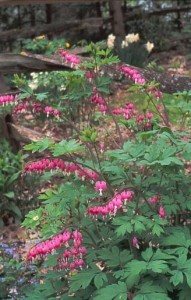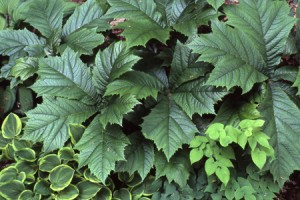A Spring Thing: Flowers in the Shade
May 31, 2009 by admin
Filed under Garden Design, Shade Gardening
Here we are at the start of June. By the time summer arrives in three weeks, the majority of perennials in northern shade gardens will already have finished blooming. Is that surprising? You may never have realized it, but most shade tolerant perennials bloom in spring.

The dangling pink hearts of Dicentra spectabilis are just a memory by the start of summer.
Think about it: hellebore, lungwort, violet, nodding mandarin, epimedium, Solomon’s seal, old-fashioned bleeding heart, most primroses, globeflower, Siberian bugloss, twinleaf, woodland phlox and many other shade standards are already done flowering. False Solomon’s seal, rodgersia, columbine, spotted geranium, bigroot geranium and mayapple are in bloom now, but they’ll be finished by late June, too. Foamflowers are fading (although if deadheaded they’ll put up more flower stalks), and the fruits of baneberry and goldenseal are already fattening up! Yup, flowers in the shade are mainly a spring thing.
What’s left to please the eyes of shade gardeners through the coming months? Goatsbeard, astilbe, hosta, bugbane, Japanese anemone, toad lily and woodland aster are all yet to come. There are more, of course, yet the fact remains that most shade perennials bloom very early in the year. I’d guesstimate 75% of them have wrapped up their flowering by the summer solstice.
There’s a good reason for that, of course. We tend to forget that plants don’t flower to please us. They have their own agenda: reproduction.
In our mostly deciduous temperate forest, the woodland is a full sun environment from November through April when the leaves aren’t on the trees. Most of that time, it’s too cold for perennials to grow, but in March and April, it’s just warm enough for them to shoot up quickly and do energy intensive things like flowering and setting seed while there’s plenty of sunlight to fuel the process. When the trees leaf out in May, many woodland perennials are winding down and looking forward to doing what we all would do if we could get away with it: lounging about all summer.

The best foliage plant ever? Hosta.
The tendency of woodland plants to flower in spring is the main reason why shade gardeners are often advised to stop focusing on flowers and instead rely heavily on exceptional foliage plants: ferns, hostas, sedges, and variegated plants such as (to name just one example) Brunnera macrophylla ‘Variegata’. Flowers will come and go in weeks, but foliage is season long.
Annuals can also help keep color going through the warm months, but the choices for shade in the north are severely limited. Begonias and impatiens are two obvious answers, and they’re readily available at low cost. Gardeners who have grown bored with wax-leaf begonias can try the dragon-wing types for some variety. These grow larger than wax-leaf begonias, are extremely floriferous and make more of an impact, but they also cost more since they aren’t available in 6-packs but have to be purchased in 4-inch pots.
Caladiums are another great choice for summer color in shade gardens, although once again the color is coming from leaves, not flowers. Caladiums are not cold hardy in the North and won’t survive winter in the ground, but they can be dug and stored, dormant, and regrown the following year if you have a bright, warm spot to start them indoors beginning in February or March. Be sure not to put them in the garden too early because they are very sensitive to cool nightime temperatures. Even here in southern New England, I’ve learned not to plant them outdoors until the first week of June. If you do get ahead of yourself with caladiums and they get whacked by an extra-cold night, they should spring back quickly as the weather warms even if their foliage dies back completely in the interim.

After their flowers have faded, rodgersia and epimedium leaves will continue to bring beauty to the shade garden.
Don’t forget that lots of those spring blooming shade plants I mentioned earlier also have great foliage that will contribute to the beauty of your garden right up until the first frost. Rodgersia, epimedium, hellebore, Solomon’s seal and twinleaf are just a few examples of plants that would be worth growing even if they didn’t flower! So, when designing your shade garden, consider each plant’s total contribution to the effect through the whole growing season, not just the loveliness of its flowers, its most ephemeral aspect.


I enjoyed your inspirational video clip. Will have to get out my garden book and look up some of the shade plants that bloom later so that I can plant them.